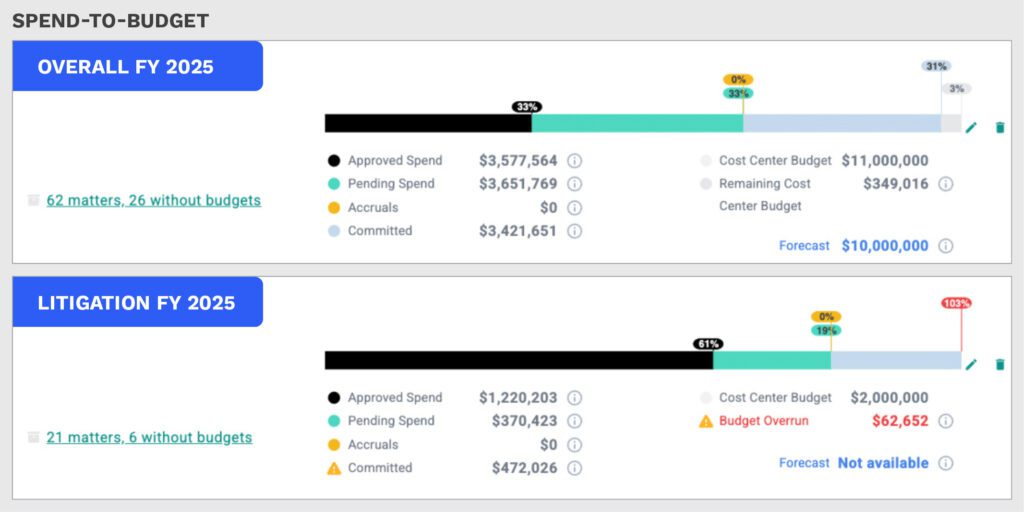How GCs Can Leverage Legal Department Metrics to Drive Strategy
By Laura Gleeson
April 21, 2025

Laura Gleeson is the General Counsel, VP of Legal and Compliance at Brightflag. She has held several senior legal roles in private practice and in-house, including as a partner at Matheson and senior counsel at construction company PM Group, giving her first-hand exposure to the importance of legal technology. She can be reached at laura.gleeson@brightflag.com.
Published in Today's General Counsel, May 2025
By tracking the right legal department metrics, general counsel obtain real-time insights into how their team is operating—and receive the data they need to chart the path forward.
But there are so many metrics capable of being tracked. How do you identify the ones that will have the biggest impact on your department?
As a general rule, the metrics your legal department tracks should answer one of these three questions:
- How efficiently are we managing our budget?
- How effectively are we managing our workload?
- How well are we leveraging outside counsel?
Below, we’ll outline some metrics that address each of these questions and show you how tracking them can improve your team’s legal operations.
Financial Management Metric: Spend-to-budget
As the general counsel, it’s important to establish the legal department as a strategic partner to the business. One way to demonstrate this is by showcasing that legal can serve as a reliable financial steward within the organization.
To build that reputation, legal must ensure it is effectively managing its budget. And tracking spend-to-budget at the overall and practice area level provides the visibility to make that possible.
Why It’s Important: At the overall level, this metric shows how your spend is tracking against legal’s budget for the year.
However, this metric becomes more meaningful for proactive financial management if you also track spend-to-budget at the practice area level, because it’s at this level that it can be used to address potential issues before they become significant problems.
For example, there may be instances where your overall spend-to-budget is on track, but diving deeper into the breakdown by practice area reveals that litigation is already at 100% of budget. Knowing this information could prompt you to reassess resourcing and avoid going over budget.
How to Track It: Create your overall and practice area budgets for the year in an e-billing and matter management system. The system can then automatically track spend to each of these budgets in real time.
Workload Management Metric: Matter Risk and Complexity
It likely goes without saying, but not all matters are created equal.
That’s why having insight into a matter’s level of risk and complexity is important—because it allows you to have a more comprehensive understanding of how much time and attention each of your legal department’s matters will require.
Why It’s Important: If you’re not tracking this aspect of your matters, you may find yourself in a situation where an individual or team appears to be working on fewer matters, but they are actually facing a heavier workload due to the high complexity of the matters they are working on.
How to Track It: To track risk and complexity, require that your team classifies matters as either low-, medium-, or high-risk and complexity when opening a matter in your e-billing and matter management system.
This, of course, requires a bit of work up-front to make those designations. However, this effort can pay dividends down the road by painting a fuller picture of the level of work your legal team is engaged with.
Outside Counsel Management Metric: Blended Rate
By illustrating the average price a law firm charged for one hour of legal work, the blended rate provides a high-level overview of how efficient your firms have been in resourcing their work.
Why It’s Important: Blended rate can be influenced by both the rates charged by individual timekeepers and the seniority of fee earners that are assigned to work (e.g. partners vs. attorneys). It is useful for comparing resourcing across your firms and signaling instances where it would be beneficial to dig a bit deeper into the resourcing of a particular law firm.
When leveraged effectively, this metric can drive meaningful conversations with your outside counsel firms that can ultimately result in increased value for money.
How to Track It: Your e-billing and matter management system can provide out-of-the-box reporting on law firm blended rates. Some systems allow you to compare the blended rate by firm for each practice area, and even leverage AI technology for deeper analysis.
For example, an analysis of blended rate among your litigation firms may reveal one firm bills at a higher blended rate than its peers. Matter management AI can help you understand why. It could highlight that this firm tends to involve more partners during the discovery and trial preparation phases of cases (a costlier option), while other firms largely limit partner time to the case strategy phase (a cheaper option). You can use this insight during your next relationship review with this firm to discuss the opportunity for a more cost-effective resourcing mix.
Conclusion
Tracking the right legal department metrics is essential to gaining a deeper understanding of how your department is currently operating, and will help you identify any areas for improved efficiency. Tracking these important metrics will also help you make informed resourcing and outsourcing decisions, and enable you to have meaningful data-driven conversations with your executive peers. Ultimately, doing so will help cement your reputation as a strategic, forward-thinking general counsel.
Must read intelligence for general counsel
Subscribe to the Daily Updates newsletter to be at the forefront of best practices and the latest legal news.
Daily Updates
Sign up for our free daily newsletter for the latest news and business legal developments.





